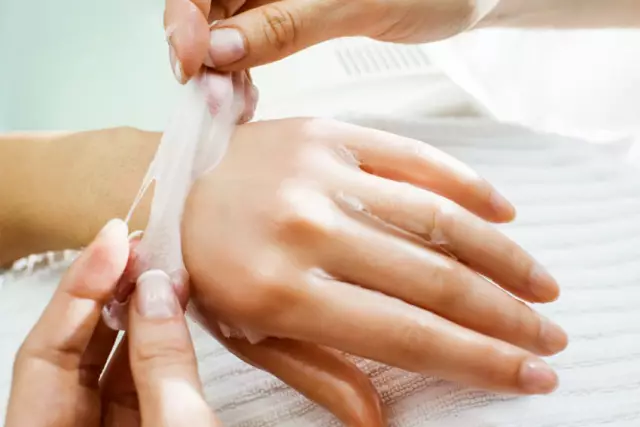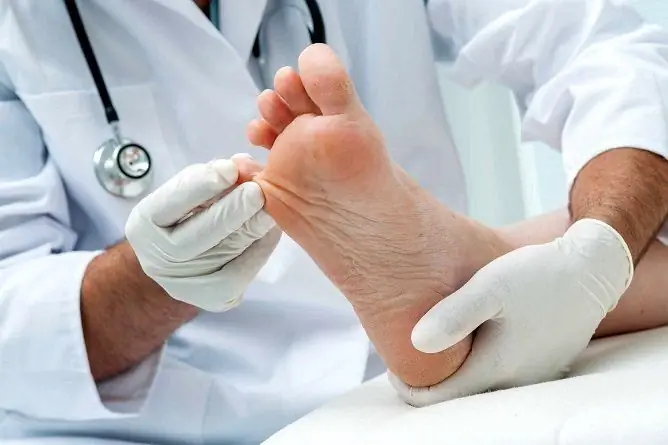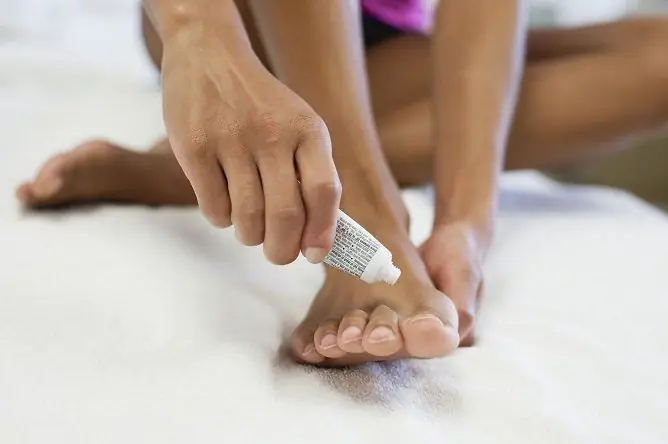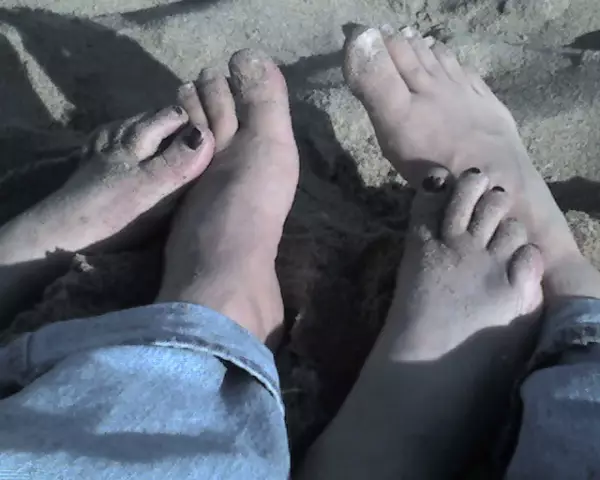- Author Rachel Wainwright [email protected].
- Public 2023-12-15 07:39.
- Last modified 2025-11-02 20:14.
Flat feet
Brief description of the disease

Flat feet is a rather paradoxical disease. On the one hand, every person has heard about it, but on the other hand, only a few people know exactly how it manifests itself, what degrees of flatfoot exist and how dangerous this disease is. We tried to answer these and many other questions in our article.
As you know, in the normal, natural state of the human foot has two arches - longitudinal (along the inner edge) and transverse (between the toes in the area of their bases). These vaults perform a very important function - they maintain balance when walking and protect the bones of the skeleton from excessive stress. In the absence of pathologies, the feet successfully cope with this task, acting together with strong ligaments and muscles. Flat feet in children and adults is manifested when the musculo-ligamentous apparatus weakens. In this case, the foot settles, becomes flat (which is why the disease got its name), and loses the ability to perform a spring (shock-absorbing) function. Depending on which arch undergoes pathological changes, there are:
- transverse flat feet - flatness of the forefoot;
- longitudinal flat feet - flattening of the longitudinal arch;
- combined form - both vaults undergo changes.
With flat feet from shaking when walking and other loads, the body will protect the spine and joints, however, they do not cope well with this task, since they were originally intended for something completely different. As a result, flat feet, the symptoms of which can occur at any age, leads to the rapid destruction of joints. This is precisely the main danger of this disease, because the patient suffers not only from rapid fatigue, but also from constant, fairly severe pain when walking, pathological disorders of posture, arthrosis and other serious disorders.
Types of flat feet
The typology of flat feet is based on the causes leading to the development of the disease. Researchers highlight:
- congenital flat feet in children - is rare, is the result of defects that appeared during the formation and development of the fetus;
- acquired flat feet - can occur at any age, is subdivided into traumatic, rickets, static and paralytic;
- traumatic - this form manifests itself after injuries, fractures of the bones of the foot, damage to soft tissues;
- rickets flat feet - treatment of this type of disease is required after suffering rickets, which disrupts the natural formation of the bones of the foot;
- static form - its appearance is associated with excess weight, too heavy loads on the foot, for example, during sports, as well as some other factors;
- paralytic flat feet - occurs after paralysis of the muscles of the foot, characteristic of poliomyelitis and a number of other orthopedic diseases.
Flat feet - symptoms and clinical picture
The main symptoms of the disease are easily identified without any special diagnostic procedures. With flat feet:
- shoes are trampled on both the outside and inside;
- a feeling of fatigue quickly develops when walking;
- cramps and swelling of the legs appear;
- you have to buy shoes one or even two sizes larger (this is due to the fact that the foot increases in width).
I would like to note that the above symptoms are typical for some other diseases, therefore, at the first unpleasant sensations, it is better for you to consult a doctor who will examine the foot and, if necessary, send you for an X-ray examination to make an accurate diagnosis.
Degrees of flat feet
The severity of the disease depends on how strong pathological changes have occurred in the foot and ligamentous apparatus.
At an early stage of the disease, doctors detect mild dysfunction of the feet, accompanied by fatigue by the end of the day. This does not change the shape of the foot.
I degree of flat feet - symptoms are more pronounced, with pressure on the foot, slight pains appear. By the evening, a person's leg often swells, but returns to its normal shape after rest.
II degree - the foot is flattened, the vaults practically disappear, which leads to significant difficulties when walking. The pains cover the entire leg, are characterized by high intensity and duration.
III degree - in this case, flat feet in children and adults leads to pronounced deformities of the foot, severe pain when walking, decreased ability to work and a drop in the quality of life. A person is no longer able to move around in ordinary shoes.
We also note that the degrees of flatfoot rather quickly replace each other due to the rapid progression of the disease. This means that the earlier you see a doctor, the higher the chance of avoiding serious complications - pain, clubfoot, disproportionate lower extremities, diseases of the feet, joints and hip apparatus.
Flat feet - treatment and prevention of the disease

Many people find it easy to treat flat feet. In fact, in the later stages of pathology, getting rid of foot deformities is very difficult, and sometimes even impossible. In this case, flat feet in children and adults can only be slowed down, but not cured completely. That is why early diagnosis of the disease and timely access to a doctor are so important.
Both longitudinal and transverse flat feet are cured only with the help of an integrated approach. Physiotherapy and medications are used to relieve pain. Remedial gymnastics is very effective, which can be done at home. It strengthens the ligamentous apparatus, trains muscles, forms the correct posture and walking stereotype. An effective set of exercises can only be prescribed by a doctor, since flat feet manifests itself in different ways depending on the rate of development of pathology, the patient's age and some other factors.
To improve blood circulation in the feet area, patients are prescribed foot baths and massage procedures. Special orthopedic insoles that relieve painful areas and correct initial deformities of the disease will also be extremely useful. Neglected flat feet, the symptoms of which are especially pronounced, are corrected with custom-made orthopedic shoes.
Surgical intervention is relevant in cases where the disease leads to severe pain and the inability to move independently, even in special shoes.
Is it possible to prevent the emergence and development of pathology of the arches of the feet? Yes you can! Prevention of flat feet consists in choosing the right, safe footwear, regular examinations by an orthopedic specialist and limiting the load on the foot.
YouTube video related to the article:
The information is generalized and provided for informational purposes only. At the first sign of illness, see your doctor. Self-medication is hazardous to health!






